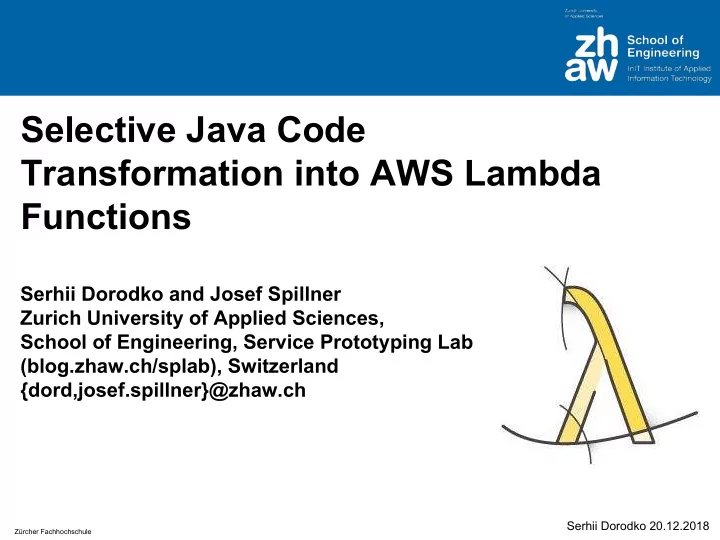

Selective Java Code Transformation into AWS Lambda Functions Serhii Dorodko and Josef Spillner Zurich University of Applied Sciences, School of Engineering, Service Prototyping Lab (blog.zhaw.ch/splab), Switzerland {dord,josef.spillner}@zhaw.ch Serhii Dorodko 20.12.2018 Zürcher Fachhochschule
Motivation: FaaS is a completely new and promising paradigm which requires specific knowledge for developers. - Provider tied development model - Data exchange model - Runtime restrictions - Packaging and deployment model Legacy code to be transformed into a new model with less resources consumption. Zürcher Fachhochschule
Podilizer: The initial research idea was to provide fully-automated approach to transform existing java-code into Lambda functions. - CLI tool - Input: Java project - Output: Appropriate set of Lambda functions deployed The approach shows satisfying results only with small projects due to complex dependency management and java-specific features Zürcher Fachhochschule
Moving to selective transformation: After the experience gained in Podilizer we decided to use annotation mechanism. - Inspired by Spring framework which is a good example of annotation usability - Gives more control in FaaSification process in a simple and understandable way - Is a part of a language Zürcher Fachhochschule
Research Questions: RQ 1 : Is it economically viable to run a Java ap- plication entirely over FaaS? RQ 2 : Is it technically feasible to automate this pro- cess?And if so, which percentage of code coverage can be expected, which performance can be achieved, and which code is easier, hard or impossible to convert? RQ 3 : Is there a friction-free integration with estab- lished Java development notations and processes? Zürcher Fachhochschule
Challenges: Disassembling java code into functions caused non trivial task to solve. In most of the cases each method has a state that needs to be handled, providing functionality correctness. Lambda programming model allows to consume and send objects, so we used it to: - Exchange current state of an object while requesting function - Return state together with the return result to update the state Class.handleRequest(input, output, context) Zürcher Fachhochschule
FaaSification Pipeline: A - static code parsing and analysis D - decomposition into functional units F -source-to-source translation of the functional units into FaaS units C - compilation and dependency assembling of these units U - upload, deployment and configuration V - verification Zürcher Fachhochschule
Termite Design: B -build G1 - Generation of functions I1 - invocation of the annotated G2 - additional sources Java application C - compilation I2 - invocation of hosted function U - Upload invocation Zürcher Fachhochschule
Implementation: This schema shows the interaction of Termite with code during the compilation and runtime phase. method1() - annotated method2() - not annotated Zürcher Fachhochschule
Code transformation: Zürcher Fachhochschule
Experiment setup: The reference input project set consists of six software applications which represent the large variety of Java software engineering, ranging from 28 to 771 significant lines of code (SLOC). The software projects are: - graphical window with buttons (P1) - mathematical functions (P2) - calculation of shipping containers and boxes (P3) - public transport information (P4) - image processing (P5) - domain-specific language parsing and evaluation (P6) An artificial project consisting of 100 numbered Java hello world methods is used as additional comparison point Zürcher Fachhochschule
Results: Lambdafication pipeline characteristics (quality) for P1–P6 with Termite Application source code size comparison before/after using Termite Zürcher Fachhochschule
Conclusion: Our findings in automated Java code to Lambda units transformation look promising for future cloud application engineering Collected in the experiments data shows, that FaaSification process is not trivial and brings significant challenges for automated migration of a legacy code into the Functions. However, we believe that the tool designs and implementations are helpful in accelerating cloud deployments despite needing more fundamental research on the OOP to FaaS mapping and tool engineering and testing. Zürcher Fachhochschule
Recommend
More recommend